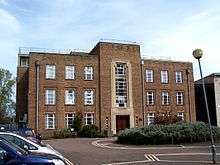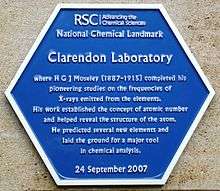Clarendon Laboratory

The Clarendon Laboratory, located on Parks Road with the Science Area in Oxford, England (not to be confused with the Clarendon Building, also in Oxford), is part of the Department of Physics at Oxford University. It houses the atomic and laser physics, condensed matter physics, and biophysics groups within the Department, although four other Oxford Physics groups are not based in the Clarendon Lab. The Oxford Centre for Quantum Computation is also housed in the laboratory.
Buildings
The Clarendon Laboratory consists of two adjoining buildings, the Lindemann Building (named after Frederick Lindemann, 1st Viscount Cherwell) and the Grade II listed Townsend Building (named after Sir John Sealy Townsend).[1][2]
A new Beecroft Building (named after Adrian Beecroft) is due to open immediately in front of the Lindemann Building in 2017, designed by Hawkins Brown, with a budget of approximately £40 million.[3][4]
History

The Clarendon is named after Edward Hyde, 1st Earl of Clarendon, whose trustees paid £10,000 for the building of the original laboratory, completed in 1872, making it the oldest purpose-built physics laboratory in England. The building was designed by Robert Bellamy Clifton.
The brothers Fritz and Heinz London developed the London equations when working there in 1935.[5]
In 2007, the laboratory was granted chemical landmark status.[6] The award was bestowed due to the work carried out by Henry Gwyn Jeffreys Moseley in 1914.
It is rumoured that the building was Tolkien's inspiration for Minas Morgul when he was writing the Lord of the Rings in the Eagle and Child nearby.
Current use
The original building, substantially enlarged, is now part of the Oxford Earth Sciences Department. The Oxford Electric Bell apparatus (also known as the Clarendon Dry Pile), constructed in 1840, is located in the foyer of the Clarendon Laboratory.
See also
- Denys Wilkinson Building, another Department of Physics building
- Department of Physics, University of Oxford
References
- ↑ "The Townsend Building, Oxford", British Listed Buildings, UK, retrieved 28 August 2015 External link in
|website=(help) - ↑ Townsend Building Conservation Plan (PDF), UK: University of Oxford, September 2010, retrieved 28 August 2015
- ↑ "The Beecroft Building". UK: Department of Physics, University of Oxford. Retrieved 28 August 2015.
- ↑ "The Beecroft Building". UK: Eckersley O'Callaghan. Retrieved 28 August 2015. External link in
|publisher=(help) - ↑ London, F.; London, H. (1935). "The Electromagnetic Equations of the Supraconductor". Proceedings of the Royal Society A. 149 (866): 71–88. Bibcode:1935RSPSA.149...71L. doi:10.1098/rspa.1935.0048. JSTOR 96265.
- ↑ RSC. "Clarendon Laboratory, University of Oxford". RSC. Retrieved 29 September 2012.
External links
| Wikimedia Commons has media related to Clarendon Laboratory. |
Coordinates: 51°45′36″N 1°15′23″W / 51.75997°N 1.2565°W